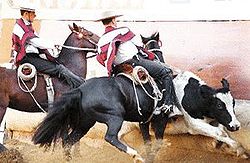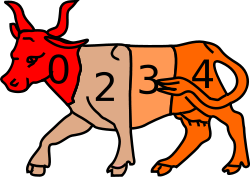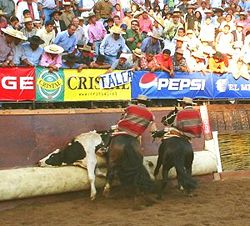- Chilean rodeo
-

Rodeo is a traditional sport in Chile. It was declared the national sport in 1962. It has since thrived, especially in the more rural areas of the country. Chilean rodeo is different from the rodeo found in North America. In Chilean rodeo, a team (called a collera) consisting of two riders (called Huasos) and two horses rides laps around an arena trying to stop a calf, pinning him against massive cushions. Points are earned for every time the steer is properly driven around the corral, with deductions for faults. Rodeos are conducted in a crescent-shaped corral called a medialuna.
The sport, in its modern form, is strictly regulated. Chilean Horses are used exclusively and riders are required to wear traditional huaso garb. Rancagua hosts the annual Campeonato Nacional de Rodeo, the nation-wide rodeo championship. The greatest rider in the sport's history is considered Ramón Cardemil, who obtained the national title seven times; the last champions were Juan Carlos Loaiza and Eduardo Tamayo. Riders practice in the countryside throughout Chile, but is most popular in the central zone. Even so, huasos have been known to travel hundreds of miles to compete in competitions.
The sport has become so popular that in 2004, more spectators attended rodeo events than professional football matches.[1]
Contents
History
The birth of Chilean rodeo is placed in the 16th century during the rule of Governor García Hurtado de Mendoza. At the time, the cattle in Chile were not well identified and it was not uncommon for the animals to get lost. To help prevent the loss, Governor Hurtado proclaimed that, in Santiago, every 24th and 25 July, the commemoration of Saint Jacob - patron saint of the city -, the cattle would be gathered in the Plaza de Armas de Santiago to be branded and selected.[2] In later years, this round-up became mandatory but, the date of the event changed to October 7, the day of Saint Mark. Though the purpose of the gathering remained the same, the riders had become extremely well trained with the constant work of transferring cattle to the various corrals.[3]
Towards the end of the 17th century, the rodeo begins to get regulated and is practiced in a rectangular track 75 meters long. The riders would bring out the cattle from the corrals and on the main track, display their abilities to separate a single calf and guide it without the help of other riders. All this activity was regulated and the most talented riders would receive honors and awards.
In the year 1860, the medialuna type track becomes the dominant track form with one apiñadero and two quinchas, where the riders have to stop the cattle. The medialuna, at this time, has a radius of 20 to 25 meters.
Standardization and regulation
During the government of General Carlos Ibáñez del Campo, in 1927, a law was passed regulating the "cattle runs", placing the Chilean rodeo under the supervision of the Chilean army.
Rodeo became, by law, a national sport on January 10, 1962 by decree Nº269 of the National Council of Sports and the Chilean Olympic Committee.[4] Beginning on May 22, 1961, the sport is regulated by the Federation of Chilean Rodeo.[5] In 1986, the National Federation of Rodeos and Huaso Clubs of Chile (Federación Nacional de Rodeos y Clubes de Huasos de Chile) is founded to regulate, to a certain degree, the "labor rodeos" (rodeo tournaments not recognized by the Olympic Committee).
In 1949, the first National Rodeo Championship occurs in the city of Rancagua and the very first champion was the team composed of Ernesto Santos and José Gutiérrez. The riders with the most victories in the history of the championship are Ramón Cardemil and Juan Carlos Loaiza, each having won the national title seven times. The most recent champions of the 2007-2008 season were Jesus Rodriguez and Christian Pooley.
Although the Chilean rodeo was declared a national sport, it finds itself in a precarious position in terms of finances, political support and promotion. Part of the reason for this is that the federation does not receive any of the revenue of Chiledeportes like the rest of sports federations in Chile. This is because only sports that represent Chile overseas receive funds. The Chilean Rodeo Federation has been critical of the government for the lack of funds towards the sport, arguing that because in many parts of the country, due to the distance from population centers, sporting events do not arrive, the local population turn to the rodeo as their primary pass time throughout the Chilean rural territory.[6] Nevertheless, thanks to the commitment and support of its many fans, the rodeo has maintained its popularity, especially in the rural areas, and its status as the second most popular sport in Chile.
Criticism
Animal rights organizations object to Chilean Rodeo and refuse to call it "sport". The arguments against this activity are related to the treatment the animals receive: the calf is driven near a wall and suddenly is hit by the horse's chest (a charge) in order to stop him. This occurs several times, although the calf is rarely[citation needed] injured or unwilling to stand up. There are constant "inspections" of the calf during the event to ensure that it is fit to continue.
In 2006, a group of 40 people protested against Chilean rodeo outside Medialuna de Rancagua where the Campeonato Nacional de Rodeo (National Championship of Chilean Rodeo) was taking place.[7]
In 2010, a group of activists entered a medialuna in the middle of a rodeo to protest, and they were violently repressed by the huasos taking part in the event. A 17 year old girl was lassoed, beaten and dragged out of the medialuna.[8]
Since then, other organizations are seeking a ban on Chilean rodeo. This is similar to the 2010 ban on Spanish bullfighting in Catalonia, Spain.
See also
External links
- National Sport
- Chilean Rodeo
- Portal del Rodeo Chileno (text in Spanish)
References
- ^ Especiales de Emol.com
- ^ Historia del rodeo chileno. Página oficial de la Federación del Rodeo Chileno
- ^ Origen del rodeo Especiales EMOL, Rodeo 2005
- ^ Rodeo chileno: cómo nació nuestro deporte nacional Familia
- ^ Federación del Rodeo Chileno Página del Portal del Rodeo Chileno
- ^ El rodeo y las medialunas
- ^ "Reactions and Controversies". El Rancahuaso. 2006. http://www.elrancahuaso.cl/admin/render/noticia/3546. Retrieved 09-08-2009.
- ^ "Joven de 17 años laceada y arrastrada en un rodeo". Youtube. 2010. http://www.youtube.com/watch?v=VTKVoisCXsY. Retrieved 02-10-2011.
Categories:- Chilean culture
- Sport in Chile
- Chilean rodeo
- Rodeo
Wikimedia Foundation. 2010.



